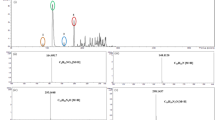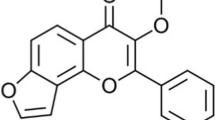Abstract
Neurological disorders pose significant challenges in terms of treatment options, necessitating the exploration of novel therapeutic approaches. Trigonelline, a naturally occurring alkaloid found in various plants, has emerged as a potential treatment option. It has also been reported that trigonelline is involved in several pathways like; Oxidative Stress and Antioxidant, Inflammatory, Neuroprotection and Neurotrophic, Mitochondrial Function and Energy Metabolism. This study aims to investigate the therapeutic potential of trigonelline for diverse neurological disorders using a molecular docking approach. Molecular docking simulations were performed to predict the binding affinity and interaction between trigonelline and target proteins implicated in neurological disorders. The structural requirements for effective binding were also explored. The molecular docking results revealed strong binding interactions and favorable binding affinities between trigonelline and the target proteins involved in diverse neurological disorders like Alzheimer’s disease, Parkinson’s disease, epilepsy, and depression etc. The predicted binding modes provided insights into the key molecular interactions governing the ligand-protein complexes. The findings suggest that trigonelline holds promise as a therapeutic approach for several neurological disorders. The molecular docking approach employed in this study provides a valuable tool for rational drug design and optimization of trigonelline-based compounds. Further experimental validation and preclinical studies are warranted to confirm the efficacy and safety of trigonelline as a potential treatment option, paving the way for the development of more effective and targeted therapies for neurological disorders.















Similar content being viewed by others
Data availability
Not applicable.
Code availability
Not applicable.
References
Adelusi TI, Oyedele A-QK, Boyenle ID et al (2022) Molecular modeling in drug discovery. Inform Med Unlocked 29:100880. https://doi.org/10.1016/j.imu.2022.100880
Ahmad S, Azhar A, Tikmani P, Rafique H, Khan A, Mesiya H, Saeed H (2022a) A randomized clinical trial to test efficacy of chamomile and saffron for neuroprotective and anti-inflammatory responses in depressive patients. Heliyon 8:e10774. https://doi.org/10.1016/j.heliyon.2022.e10774
Ahmad S, Khan A, Tabassum S et al (2022b) Co-administration of saffron and chamomile give additive effects of antidiabetic and antioxidant activity with in vivo augmentation of brain BDNF, acetylcholine levels and cognitive functions in Streptozotocininduced diabetic rats. Curr Psychopharmacol 11:56–69. https://doi.org/10.2174/2211556010666210906153253
Ahmad S, Rafiq H, Khan A et al (2022c) Ameliorative effects of half-dose saffron and chamomile combination on psycho-endocrinological changes in a diabetic murine model. PLoS One 17:e0276236. https://doi.org/10.1371/journal.pone.0276236
Ahmad S, Ahmed SB, Khan A et al (2023) Natural remedies for Alzheimer's disease: a systematic review of randomized controlled trials. Metab Brain Dis 38:17–44. https://doi.org/10.1007/s11011-022-01063-9
Amin F, Ibrahim MAA, Rizwan-Ul-Hasan S et al (2022) Interactions of Apigenin and Safranal with the 5HT1A and 5HT2A receptors and behavioral effects in depression and anxiety: a molecular docking, lipid-mediated molecular dynamics, and in vivo analysis. Molecules 27. https://doi.org/10.3390/molecules27248658
Arlt A, Sebens S, Krebs S et al (2013) Inhibition of the Nrf2 transcription factor by the alkaloid trigonelline renders pancreatic cancer cells more susceptible to apoptosis through decreased proteasomal gene expression and proteasome activity. Oncogene 32:4825–4835. https://doi.org/10.1038/onc.2012.493
Attique SA, Hassan M, Usman M et al (2019) A molecular docking approach to evaluate the pharmacological properties of natural and synthetic treatment candidates for use against hypertension. Int J Environ Res Public Health 16. https://doi.org/10.3390/ijerph16060923
Berman HM, Battistuz T, Bhat TN et al (2002) The protein data bank. Acta Crystallogr D Biol Crystallogr 58:899–907. https://doi.org/10.1107/s0907444902003451
Castañeda R, Rodriguez I, Nam YH, Hong BN, Kang TH (2017) Trigonelline promotes auditory function through nerve growth factor signaling on diabetic animal models. Phytomedicine 36:128–136. https://doi.org/10.1016/j.phymed.2017.09.023
Chowdhury AA, Gawali NB, Bulani VD, Kothavade PS, Mestry SN, Deshpande PS, Juvekar AR (2018a) In vitro antiglycating effect and in vivo neuroprotective activity of Trigonelline in d-galactose induced cognitive impairment. Pharmacol Rep 70:372–377. https://doi.org/10.1016/j.pharep.2017.09.006
Chowdhury AA, Gawali NB, Munshi R, Juvekar AR (2018b) Trigonelline insulates against oxidative stress, proinflammatory cytokines and restores BDNF levels in lipopolysaccharide induced cognitive impairment in adult mice. Metab Brain Dis 33:681–691. https://doi.org/10.1007/s11011-017-0147-5
de Mol NJ, Fischer MJ (2008) Kinetic and thermodynamic analysis of ligand-receptor interactions: SPR applications in drug development. Handbook of surface plasmon resonance, pp 123–172. https://doi.org/10.1039/9780854042678-00123
de Ruyck J, Brysbaert G, Blossey R, Lensink MF (2016) Molecular docking as a popular tool in drug design, an in silico travel. Adv Appl Bioinform Chem 9:1–11. https://doi.org/10.2147/aabc.s105289
Fahanik-Babaei J, Baluchnejadmojarad T, Nikbakht F, Roghani M (2019) Trigonelline protects hippocampus against intracerebral Aβ(1-40) as a model of Alzheimer's disease in the rat: insights into underlying mechanisms. Metab Brain Dis 34:191–201. https://doi.org/10.1007/s11011-018-0338-8
Fahrrolfes R, Bietz S, Flachsenberg F et al (2017) ProteinsPlus: a web portal for structure analysis of macromolecules. Nucleic Acids Res 45:W337–W343. https://doi.org/10.1093/nar/gkx333
Farid MM, Yang X, Kuboyama T, Tohda C (2020) Trigonelline recovers memory function in Alzheimer's disease model mice: evidence of brain penetration and target molecule. Sci Rep 10:16424. https://doi.org/10.1038/s41598-020-73514-1
Folwarczna J, Zych M, Nowinska B, Pytlik M, Janas A (2014) Unfavorable effect of trigonelline, an alkaloid present in coffee and fenugreek, on bone mechanical properties in estrogen-deficient rats. Mol Nutr Food Res 58:1457–1464. https://doi.org/10.1002/mnfr.201300936
Fouzder C, Mukhuty A, Mukherjee S, Malick C, Kundu R (2021) Trigonelline inhibits Nrf2 via EGFR signalling pathway and augments efficacy of cisplatin and etoposide in NSCLC cells. Toxicol in Vitro 70:105038. https://doi.org/10.1016/j.tiv.2020.105038
Iqbal A (2023) Molecular docking in the study of ligand-protein recognition: an overview. In: Erman Salih I (ed) Molecular Docking. IntechOpen, Rijeka, p Ch. 4. https://doi.org/10.5772/intechopen.106583
Javad F-B, Tourandokht B, Farnaz N, Mehrdad R (2019) Trigonelline ameliorates learning and memory and synaptic plasticity impairment in Intrahippocampal amyloid Beta (1-40) rat model of Alzheimer’s disease. Acta Medica Iranica 56(10). https://acta.tums.ac.ir/index.php/acta/article/view/6874
Khalili M, Alavi M, Esmaeil-Jamaat E, Baluchnejadmojarad T, Roghani M (2018) Trigonelline mitigates lipopolysaccharide-induced learning and memory impairment in the rat due to its anti-oxidative and anti-inflammatory effect. Int Immunopharmacol 61:355–362. https://doi.org/10.1016/j.intimp.2018.06.019
Khan RA, Assad T, Rajput MA (2017) Anticonvulsant effects of Trigonella foenum-graecum L. in strychnine induced epilepsy model. J Nutrition Health Food Sci 5(7):1–6
Konstantinidis N, Franke H, Schwarz S, Lachenmeier DW (2023) Risk assessment of Trigonelline in coffee and coffee by-products. Molecules 28. https://doi.org/10.3390/molecules28083460
Liang Y, Dai X, Cao Y et al (2023) The neuroprotective and antidiabetic effects of trigonelline: a review of signaling pathways and molecular mechanisms. Biochimie 206:93–104. https://doi.org/10.1016/j.biochi.2022.10.009
Lorigooini Z, Sadeghi Dehsahraei K, Bijad E, Habibian Dehkordi S, Amini-Khoei H (2020) Trigonelline through the attenuation of oxidative stress exerts antidepressant- and anxiolytic-like effects in a mouse model of maternal separation stress. Pharmacology 105:289–299. https://doi.org/10.1159/000503728
Luo W, Deng J, He J et al (2023) Integration of molecular docking, molecular dynamics and network pharmacology to explore the multi-target pharmacology of fenugreek against diabetes. J Cell Mol Med. https://doi.org/10.1111/jcmm.17787
Martinez JC, Murciano-Calles J, Cobos ES, Iglesias-Bexiga M, Luque I, Ruiz-Sanz J (2013) Isothermal titration calorimetry: thermodynamic analysis of the binding thermograms of molecular recognition events by using equilibrium models, vol 4. InTech. https://doi.org/10.5772/53311
Meng XY, Zhang HX, Mezei M, Cui M (2011) Molecular docking: a powerful approach for structure-based drug discovery. Curr Comput Aided Drug Des 7:146–157. https://doi.org/10.2174/157340911795677602
Mirzaie M, Khalili M, Kiasalari Z, Roghani M (2016) Neuroprotective and Antiapoptotic potential of Trigonelline in a striatal 6-Hydroxydopamine rat model of Parkinson’s disease. Neurophysiology 48:176–183. https://doi.org/10.1007/s11062-016-9586-6
Nugrahini AD, Ishida M, Nakagawa T, Nishi K, Sugahara T (2020) Trigonelline: an alkaloid with anti-degranulation properties. Mol Immunol 118:201–209
Okoh OS, Yakubu A, Adegboyega AE et al (2023) Identification of some bioactive compounds from Trignonella foenumgraecum as possible inhibitors of PPARϒ for diabetes treatment through molecular docking studies, pharmacophore modelling and ADMET profiling: an in-silico study. PLoS One 18:e0284210. https://doi.org/10.1371/journal.pone.0284210
Pinzi L, Rastelli G (2019) Molecular docking: shifting paradigms in drug discovery. Int J Mol Sci 20. https://doi.org/10.3390/ijms20184331
Prieto-Martínez FD, Arciniega M, Medina-Franco JL (2018) Molecular docking: current advances and challenges. TIP Revista especializada en ciencias químico-biológicas, p 21. https://doi.org/10.22201/fesz.23958723e.2018.0.143
Qiu Z, Wang K, Jiang C et al (2020) Trigonelline protects hippocampal neurons from oxygen-glucose deprivation-induced injury through activating the PI3K/Akt pathway. Chem Biol Interact 317:108946. https://doi.org/10.1016/j.cbi.2020.108946
Roshana Devi V, Sharmila C, Subramanian S (2018) Molecular docking studies involving the inhibitory effect of Gymnemic acid, Trigonelline and Ferulic acid, the phytochemicals with antidiabetic properties, on glycogen synthase kinase 3 (α and β). J App Pharm Sci 8(4):150–160. https://doi.org/10.7324/JAPS.2018.8422
Ruggiero M, Calvello R, Porro C, Messina G, Cianciulli A, Panaro MA (2022) Neurodegenerative diseases: can caffeine be a powerful ally to weaken neuroinflammation? Int J Mol Sci 23(21):12958. https://doi.org/10.3390/ijms232112958
Shen Q, Fang J, Guo H et al (2023) Astragaloside IV attenuates podocyte apoptosis through ameliorating mitochondrial dysfunction by up-regulated Nrf2-ARE/TFAM signaling in diabetic kidney disease. Free Radic Biol Med 203:45–57. https://doi.org/10.1016/j.freeradbiomed.2023.03.022
Socala K, Szopa A, Serefko A, Poleszak E, Wlaz P (2020) Neuroprotective effects of coffee bioactive compounds: a review. Int J Mol Sci 22(1):107. https://doi.org/10.3390/ijms22010107
Sun J, Li JY, Zhang LQ et al (2021) Nrf2 activation attenuates chronic constriction injury-induced neuropathic pain via induction of PGC-1alpha-mediated mitochondrial biogenesis in the spinal cord. Oxidative Med Cell Longev 2021:9577874. https://doi.org/10.1155/2021/9577874
Torres PHM, Sodero ACR, Jofily P, Silva-Jr FP (2019) Key topics in molecular docking for drug design. Int J Mol Sci 20. https://doi.org/10.3390/ijms20184574
Zameer S, Najmi AK, Vohora D, Akhtar M (2018) A review on therapeutic potentials of Trigonella foenum graecum (fenugreek) and its chemical constituents in neurological disorders: complementary roles to its hypolipidemic, hypoglycemic, and antioxidant potential. Nutr Neurosci 21:539–545. https://doi.org/10.1080/1028415X.2017.1327200
Zhang W, Zhang Y, Chen S et al (2021) Trigonelline, an alkaloid from Leonurus japonicus Houtt., suppresses mast cell activation and OVA-induced allergic asthma. Front Pharmacol 12:687970. https://doi.org/10.3389/fphar.2021.687970
Zhang J, Xu H-X, Zhu J-Q, Dou Y-X, Xian Y-F, Lin Z-X (2023) Natural Nrf2 inhibitors: a review of their potential for Cancer treatment. Int J Biol Sci 19:3029–3041. https://doi.org/10.7150/ijbs.82401
Zhou J, Chan L, Zhou S (2012) Trigonelline: a plant alkaloid with therapeutic potential for diabetes and central nervous system disease. Curr Med Chem 19:3523–3531. https://doi.org/10.2174/092986712801323171
Funding
Not applicable.
Author information
Authors and Affiliations
Contributions
The study conception and design were a collaborative effort involving all authors. Syeda Rehana Zia, Muhammad Wasim, and Saara Ahmad were responsible for material preparation, data collection, and analysis. The initial draft of the manuscript was jointly written by Syeda Rehana Zia and Muhammad Wasim, and all authors provided feedback on earlier versions of the manuscript. The final manuscript was thoroughly reviewed and approved by all authors, including Saara Ahmad.
Corresponding author
Ethics declarations
Ethics approval
Not applicable.
Consent to participate
Not applicable.
Consent for publication
Not applicable.
Conflict of interest
Nothing to declare. The research was conducted in the absence of any financial and commercial relationship.
Additional information
Publisher’s Note
Springer Nature remains neutral with regard to jurisdictional claims in published maps and institutional affiliations.
Syeda Rehana Zia and Muhammad Wasim shared first author
Supplementary Information
ESM 1
(DOCX 543 kb)
Rights and permissions
Springer Nature or its licensor (e.g. a society or other partner) holds exclusive rights to this article under a publishing agreement with the author(s) or other rightsholder(s); author self-archiving of the accepted manuscript version of this article is solely governed by the terms of such publishing agreement and applicable law.
About this article
Cite this article
Zia, S.R., Wasim, M. & Ahmad, S. Unlocking therapeutic potential of trigonelline through molecular docking as a promising approach for treating diverse neurological disorders. Metab Brain Dis 38, 2721–2733 (2023). https://doi.org/10.1007/s11011-023-01304-5
Received:
Accepted:
Published:
Issue Date:
DOI: https://doi.org/10.1007/s11011-023-01304-5




